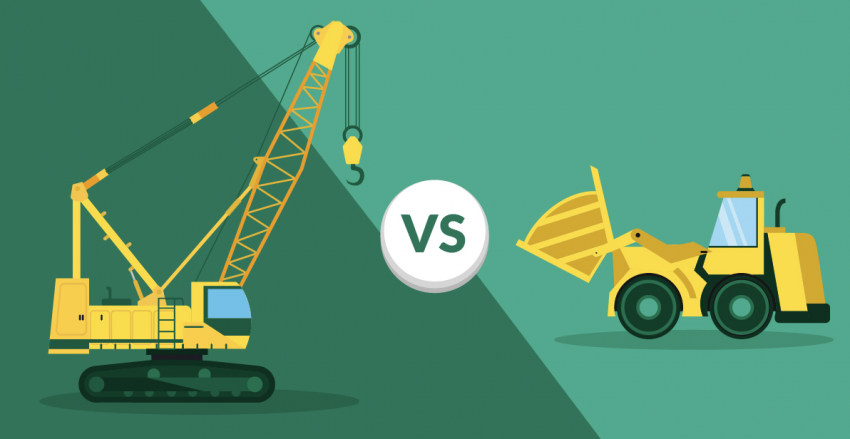Inside this Article
PayPal
 Founded back in 1998, PayPal is one of the oldest and best-known methods for individuals to send and receive money online. The company specializes in electronic money transfers, and is used by many websites, organizations, freelancers, and online stores as a primary means of receiving payment. They’re even the most commonly used method of withdrawing money on the popular freelance platforms Fiverr and Freelancer.com. PayPal is currently the largest platform of this type, although, they’re not ideal for everybody.
Founded back in 1998, PayPal is one of the oldest and best-known methods for individuals to send and receive money online. The company specializes in electronic money transfers, and is used by many websites, organizations, freelancers, and online stores as a primary means of receiving payment. They’re even the most commonly used method of withdrawing money on the popular freelance platforms Fiverr and Freelancer.com. PayPal is currently the largest platform of this type, although, they’re not ideal for everybody.
Pros
Here are a few of the primary reasons that PayPal has grown to host more than 244 million active users:- Receive payment from clients simply by using your email address, and they don’t even need to have a PayPal account! This also makes it unnecessary to divulge any personal information, such as your billing address, bank account number, or even your name
- Widely available and recognized across the globe. Currently, PayPal is offered in more than 200 countries and is able to support 25 different currency types
- Clients tend to trust transactions that are handled through PayPal due to their great buyer protection policies that allow clients to seek a refund if they believe a freelancer hasn’t met their end of the deal
- Payments transfer within minutes when clients pay using either credit, debit, or with their PayPal balance. Although, those made by eChecks or bank transfers won’t be available to you until they’ve cleared with the bank, which takes about one day for bank transfers, and anywhere from three to six days for an eCheck
Cons
While there are plenty of advantages to using PayPal to collect payments, it’s still far from perfect, with disadvantages that include:- Can be risky for merchants (which includes freelancers) as PayPal tends to provide far more protections for purchasers than they do for sellers. This means that if a customer decides to dispute a transaction (even months down the line as PayPal gives buyers 180 days to raise a dispute), there’s a risk that PayPal will rule in their favor, causing you to lose out entirely. This is especially an issue for digital goods, as PayPal offers no seller protection for these products
- Overall, PayPal charges higher fees than many other options. Fees on PayPal are based on the country from which you’re operating, as well as the country (and currency) that your client is based out of. For domestic sales, most countries pay 3.4% of the total sale amount, in addition to a fixed fee, which hovers around $0.30 USD, but varies by location. For those in much of Latin America, as well as some Asian and African countries, the fees can be a bit higher, reaching up to 5.4% of the total transaction amount plus the fixed fee. To top this off, if a client pays you in a foreign currency, you’ll be hit with an additional exchange rate fee of between 2.5% and 4.5% of the total sale, depending on the currency type
- PayPal can put a hold on your funds for up to 21 days for just about any reason. Some potential causes of holds include: if your account is new, hasn’t been used in a while, has received multiple disputes, or your selling pattern has changed. Verifying your account can help to mitigate the risk of this happening, but it doesn’t offer any guarantees
- Your account can be frozen without notice, which can be difficult and time-consuming to reinstate. The internet is littered with horror stories of accounts that were frozen, barring access to funds, sometimes for up to six months! This can be especially problematic for those freelancing as a digital nomad, as constant transactions and logins from different countries are almost guaranteed to get your account frozen
The Takeaway
PayPal is potentially an excellent choice for many freelancers, and, oftentimes, it may even be the only one available. Therefore, it’s common that freelancers use this payment option fairly regularly, although there are some who are better off avoiding it altogether: mainly those that live in one of the many countries where they charge astronomically high fees (predominately in Latin America), or those who sell digital goods. Otherwise, their service—while a bit expensive—is overall quick and easy to use, and nearly universally trusted, generally making PayPal a solid option.Payoneer
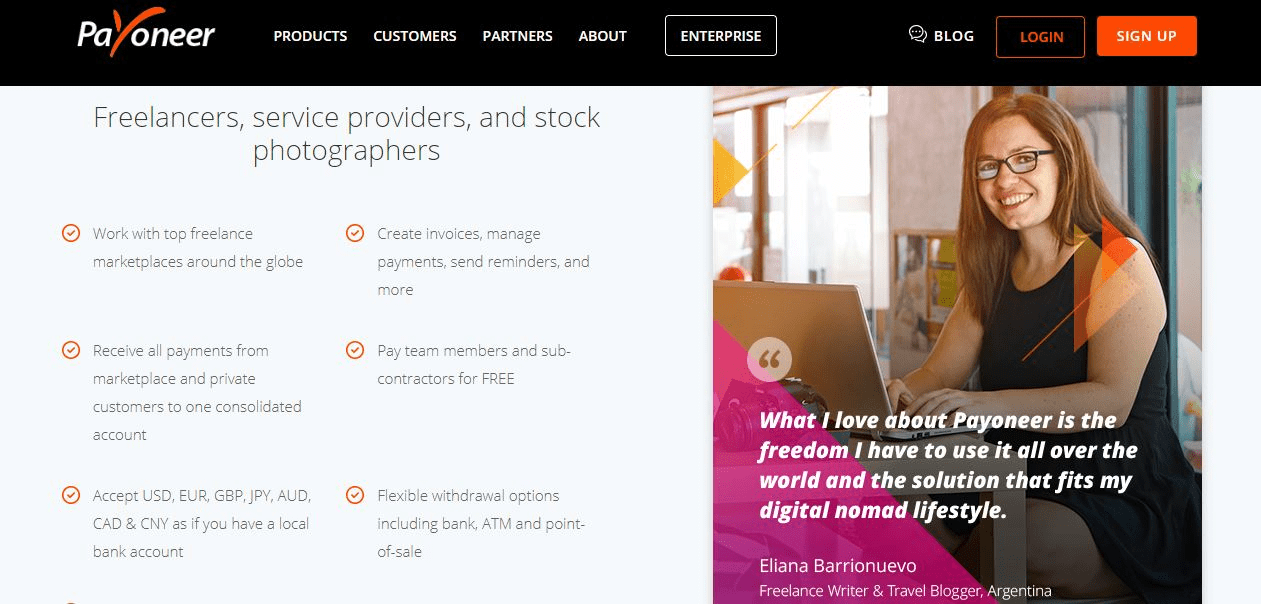 Partnered with Freelance giant Upwork, Payoneer is a massive digital payment service that specializes in international transactions. Payoneer is rather similar to PayPal in many ways, as they can be used to store, transfer, and receive funds, as well as provide a reloadable debit MasterCard. Although, while the two companies fulfill quite similar roles, there are some key differences that set them apart.
Partnered with Freelance giant Upwork, Payoneer is a massive digital payment service that specializes in international transactions. Payoneer is rather similar to PayPal in many ways, as they can be used to store, transfer, and receive funds, as well as provide a reloadable debit MasterCard. Although, while the two companies fulfill quite similar roles, there are some key differences that set them apart.
Pros
Some of the major benefits of using Payoneer to receive payments are:- Available in 150 different currencies and in more than 200 countries, making them ideal for international transactions. They’re able to accomplish this by using banking networks across the globe, making receiving payments in foreign currencies generally cheaper
- Receive free payments if coming from other Payoneer customers in USD, GBP, JPY, and EUR. And, while there are fees associated with other payment sources, they’re overall much lower than many competing platforms. There’s a flat 3% charge for credit card payments in any currency, and only a 1% charge for eChecks
- Receive payments relatively quickly compared to some other methods. Payments should appear in your Payoneer account within no more than two hours
Cons
Some of the less appealing aspects of using Payoneer include:- Costs up to 2% above the mid-market rate when withdrawing payments made in a foreign currency to your local bank account. If transferred to an account that operates in the same currency, there’s a flat fee, but only for USD, GBP, and EUR. These fees are in addition to any charged by your bank
- Payoneer’s prepaid MasterCard is loaded with fees, including an annual $29.95 USD charge (which is insane for a prepaid card). Their ATM withdrawal fees are also rather high, and while the amount varies depending on the currency being withdrawn, they’re all close to $3 USD per transaction
- Transferring money from Payoneer to your local account can take three to five days. And, as the only means of accessing your funds short of using their expensive debit card, this can be rather inconvenient, especially if you need your money in a rush
The Takeaway
Payoneer is great for international freelancers due to their ability to handle such a wide number of currencies across so many different countries. Their association with giant freelance platforms also makes them an obvious choice for those working on them, although the platforms themselves may use a different fee structure. Payoneer may not be ideal if you’re someone who needs access to their money relatively quickly and doesn’t want to pay exorbitant ATM fees. But, if willing to wait, Payoneer is a potentially cheaper option than PayPal and other competing options.Stripe
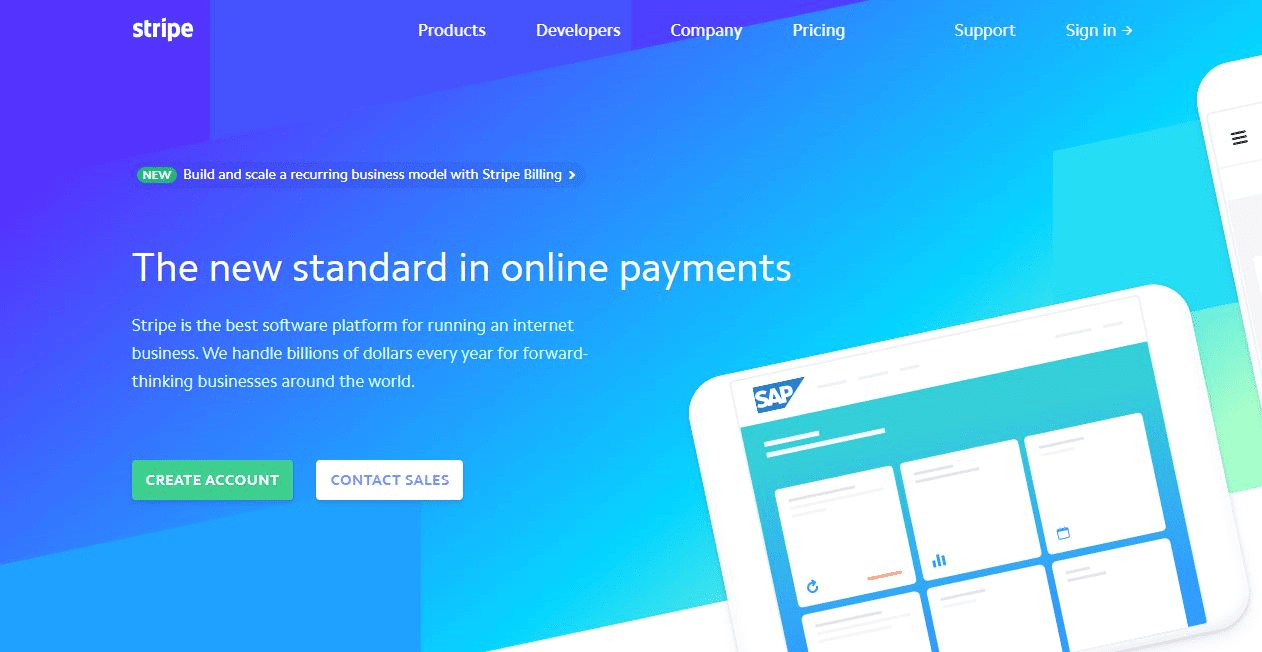 Stripe is mainly used to accept payments from clients, and is less focused on the money transferring services that other options emphasize. While relatively new compared to PayPal or Payoneer, Stripe is still utilized by countless small businesses and freelancers for their payment needs.
Stripe is mainly used to accept payments from clients, and is less focused on the money transferring services that other options emphasize. While relatively new compared to PayPal or Payoneer, Stripe is still utilized by countless small businesses and freelancers for their payment needs.
Pros
Some of the benefits experienced by freelancers paid through Stripe include:- Some of the lowest fees among payment options, at 2.9%, with an additional $0.30 USD flat fee per transaction. For international cards paying in a different currency, another 1% conversion charge may apply
- Their two-day rolling payout schedule allows for you to receive payments daily. Available in the U.S. and Australia, Stripe’s two-day rolling payout means that you’ll be paid every day for the work that was completed two days ago
- No minimum amount for withdrawing funds other than in a few select countries. But, even then, the minimum amounts are incredibly low, at around $1 USD (although this varies by location)
Cons
The main downsides to this payment method are:- Lacks the trust and reputation of more established payment channels. Due to being relatively new when compared to other options, such as PayPal and Payoneer, Stripe has yet to earn the same level of trust. For this reason, even if Stripe is your preferred method of getting paid, some clients may still request to use PayPal, or another more well-known option
- Only 26 countries are currently able to accept payments with Stripe, although they can be accepted from anywhere in the world
- When a client disputes a payment, you’re charged a $15 USD fee that is only refunded if the client loses the dispute. If you lose, you not only pay the $15 fee, but you also have to refund the client, as well as still being forced to pay the Stripe transaction fee
The Takeaway
Stripe is a great option for most freelancers that live in one of the 26 countries in which they’re available, as they’re generally cheaper. It’s also good for international transactions, as their fees are relatively low compared to some other options. Stripe isn’t the greatest for freelancers that subsist on many small transactions that are $10 USD or less, as they don’t offer any sort of price break for microtransactions, meaning the $0.30 flat fees can add up rather quickly.
In a hurry?
Take this short quiz and find the best freelancer platform in seconds
Wire Transfers
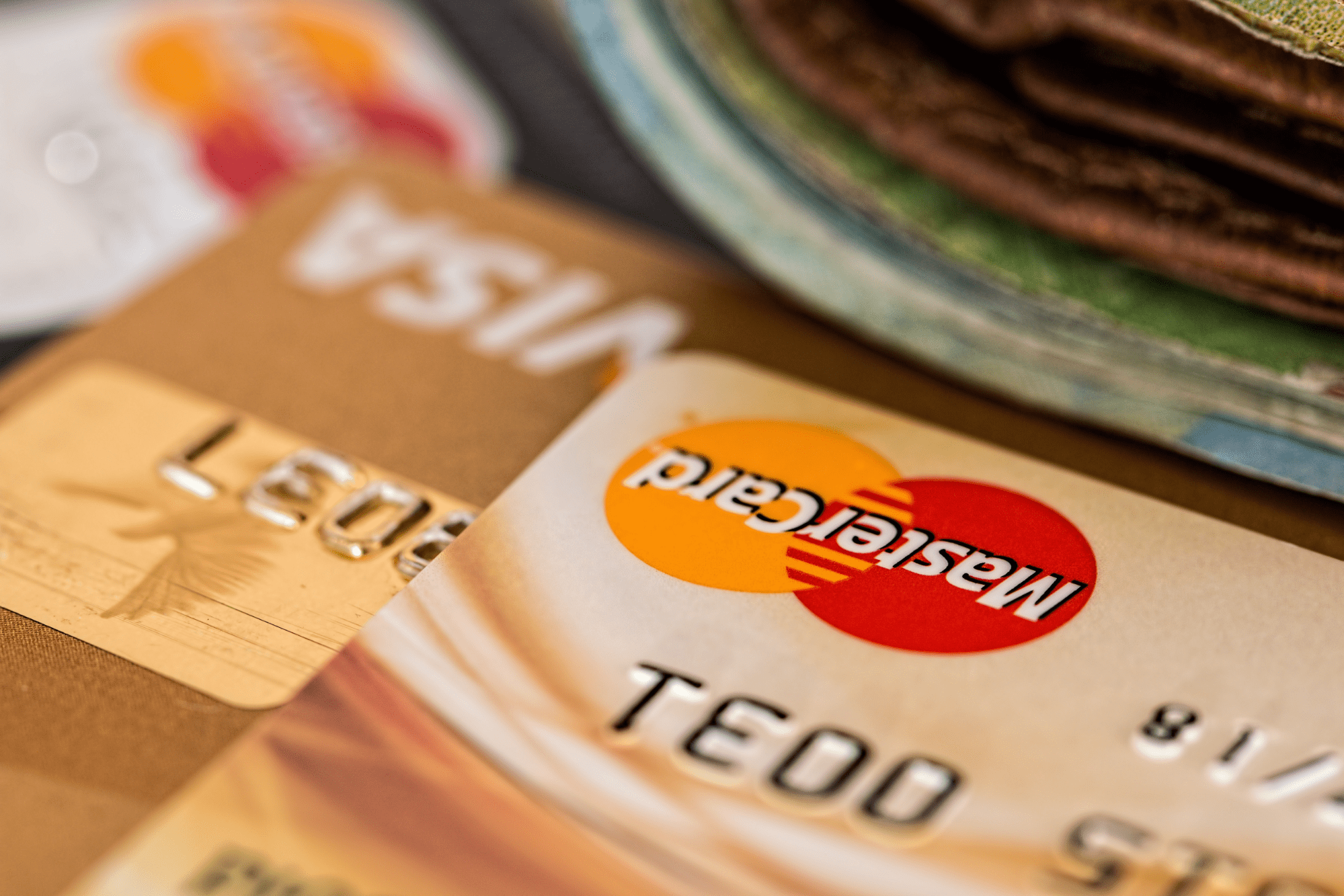 A wire transfer is a method of moving funds directly from one bank account into another. While not the most common option among freelancers, some clients do pay via this method.
A wire transfer is a method of moving funds directly from one bank account into another. While not the most common option among freelancers, some clients do pay via this method.
Pros
A number of freelancers are drawn to wire transfers because they are:- Available internationally, although international processing fees can be expensive, and may also take quite a bit longer
- A very secure form of payment as the banks basically treat a wire transfer as a digital cashier’s check, and will clear the funds as soon as they’re received
- Very fast with processing, especially domestically, where the money can be in your account and ready to spend in just a few hours. Internationally, they may take up to a couple days, but they’re still quicker than many other methods
Cons
Some reasons why many freelancers avoid wire transfers include:- The high costs associated, as they can cost the sender, if in the U.S., $25 for a domestic transfer and $43 for an international one. On top of this, the receiver (you) may have to pay an additional $8 to $10 fee
- Clients are less likely to trust a wire transfer as once they submit payment they have no recourse if you don’t follow through on your work. Clients with whom you’ve established a relationship would be more likely to pay in this manner
- They’re not economically viable for smaller priced projects. Projects priced $500 USD or less probably don’t warrant the costs associated with this payment method
The Takeaway
With the insane fees associated with wire transfers, they’re really only a viable option for high-priced projects that require a very secure method of payment, unless your client is covering the fees. Otherwise, stick to a more economical option, as some can be nearly as fast anyways.Freelance Websites
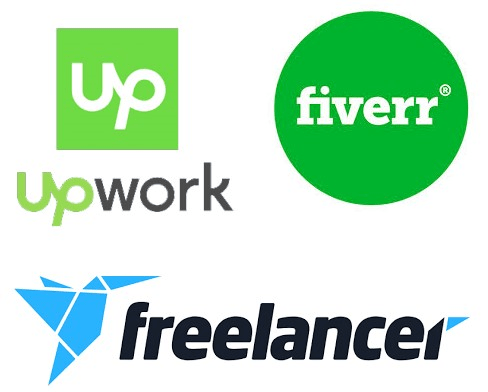 Many freelancers choose to use one of the available freelance platforms to process their payments rather than relying on one of the above methods. That being said, most platforms still utilize one of the payment providers such as PayPal or Payoneer to actually process their payments, only it’s invoiced and transferred to you through the freelance platform. Therefore, even if using a freelance platform, it may still be necessary to create an account through one of the aforementioned payment channels.
Many freelancers choose to use one of the available freelance platforms to process their payments rather than relying on one of the above methods. That being said, most platforms still utilize one of the payment providers such as PayPal or Payoneer to actually process their payments, only it’s invoiced and transferred to you through the freelance platform. Therefore, even if using a freelance platform, it may still be necessary to create an account through one of the aforementioned payment channels.
Pros
Freelance websites are often used for the following reasons:- They offer better protections for freelancers, greatly reducing the chances of being scammed. These platforms specialize in freelancing, so they usually have solid measures in place, such as an escrow system that ensures clients pay upon completion of the project
- Ability to track your time and help to easily invoice clients. Creating invoices and tracking your time can be an issue for some remote workers, but not when using a quality freelance platform. Most have a feature to easily track your time, and automatically invoice clients either on a predetermined schedule or upon the acceptance of completed work
- Also act as amazing tools for locating additional clients, which is probably the primary reason so many freelancers stick to these platforms. It’s often hard to find clients, especially when first starting out as a freelancer, and these platforms greatly simplify the process
Cons
Some of the negative aspects of using a freelance platform are:- Generally include much higher fees than other options, although exactly how high they are is dependent on the platform being used. Fees across platforms vary, but can be as high as 20% of your total earnings! On top of this, some platforms charge additional fees for transferring funds into your bank account, making them a rather costly option
- It may take a while after project completion until the money hits your account because many platforms put a hold on your money for several days before allowing you to begin the withdrawal process. Once the withdrawal has begun, it can take an additional two to five days before the funds become available
- Many available choices, with some being far better than others. This means that you’ll have to do a bit of homework if you intend to use one of these platforms. A great place to start is by reading our reviews on what it’s like to work on some of the most popular platforms: Upwork, Freelancer.com, and Fiverr
The Takeaway
While these platforms may be among the more expensive payment options on this list, the benefits they offer make the associated costs well worth it for many freelancers, especially those just starting out and who’ve yet to establish relationships with any clients. Due to their relative security, ease of locating clients, and handy review systems, these platforms are an excellent way to get yourself established as a freelancer and start building your portfolio.Choosing the Best Option
Now that you possess various options, you will need to determine which one aligns most effectively with your requirements. This determination relies on several factors, such as geographical location, personal needs, and client expectations, to mention just a few. When deciding on your payment method, it’s important to take everything into consideration to avoid any unwanted problems down the line. The table below summarizes each of the above payment options, giving you a quick and easy way to compare the advantages and disadvantages, and helping you decide whether or not they could work for you.| Payment Method | Are There Fees? | Waiting Time | Main Advantage | Main Disadvantage | When This Option’s Ideal |
|---|---|---|---|---|---|
| PayPal | ✔ | Depends on method of payment, can be anywhere from a few minutes to six days (eChecks) | Widely available and trusted by clients | Seller protections are somewhat lacking | When a client doesn’t trust other payment methods, and you’re not offering digital goods |
| Payoneer | ✔ | Around two hours to receive payments, but three to five days to transfer to your account | Receive free payments from other Payoneer customers | The fees associated with their prepaid MasterCard are kind of ridiculous | If you’re an international seller that receives payments in many different currencies |
| Stripe | ✔ | First transfer can take up to ten days, after which, around two days, but may vary by country | Generally lower fees than most other options | Available in few countries | Anyone who lives in one of the 26 countries it’s available in who doesn’t rely on microtransactions |
| Wire Transfer | ✔ | A few hours domestically, and a few days internationally | Very secure form of payment for receivers | Especially high processing fees for international transactions | Ideal for high priced projects requiring a very secure payment method |
| Freelance Websites | ✔ | Depends on platform, but usually several days minimum | Offer some of the best protections for freelancers | Have some of the highest fees when getting paid | Great for freelancers that are looking to establish new client relationships |




